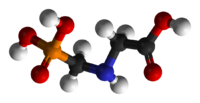
Photo from wikipedia
BACKGROUND Glyphosate is the most commonly used herbicide in the world, being used in agriculture, forestry, and urban settings. In regions with high glyphosate use, such as agricultural, glyphosate and… Click to show full abstract
BACKGROUND Glyphosate is the most commonly used herbicide in the world, being used in agriculture, forestry, and urban settings. In regions with high glyphosate use, such as agricultural, glyphosate and its' major derivative aminomethylphosphonic acid (AMPA) are frequently detected in surface waters. In Canadian forestry glyphosate-based herbicides are used to control vegetation that competes with conifer trees and are applied one to two times during a rotation, leading to infrequent application to the same area. Forestry occurs over a large spatial extent, and the cumulative application in space can lead to a large percentage of the land base receiving an application through time. To assess the frequency and concentration of glyphosate and AMPA in surface waters of a region where forestry is the dominant use sector we conducted three monitoring programs targeting; 1) immediately after application, 2) after rainfall, and 3) cumulative application over a large spatial extent. RESULTS Across all monitoring programs we collected 296 water samples between August and October from eight river systems over two years and detected glyphosate in one sample at 17 ppb. CONCLUSION Glyphosate is not likely present in surface waters during baseflow conditions as a result of applications in forestry. Lack of detection is likely because soil capacity to bind glyphosate remains high due to infrequent applications to the same area, and factors that limit sediment transport to surface waters such as buffers. Additional sampling is needed during other stream conditions, ideally spring freshet, to determine peak concentrations. This article is protected by copyright. All rights reserved.
Journal Title: Pest management science
Year Published: 2023
Link to full text (if available)
Share on Social Media: Sign Up to like & get
recommendations!